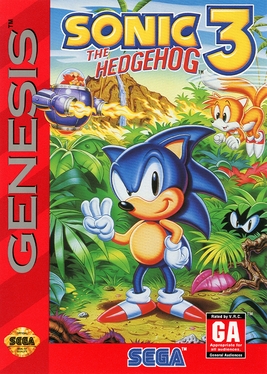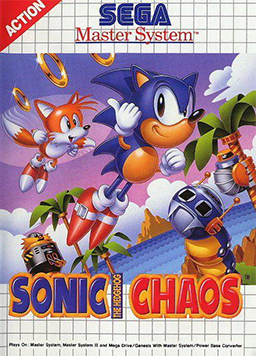Sonic Team is a video game developer owned by the Japanese video game company Sega as part of its Sega CS Research and Development No. 2 division. Sonic Team is best known for its Sonic the Hedgehog series and games such as Nights into Dreams and Phantasy Star Online.

Sonic the Hedgehog 3 is a 1994 platform game developed and published by Sega for the Sega Genesis. Like previous Sonic games, players traverse side-scrolling levels while collecting rings and defeating enemies. They control Sonic and Tails, who attempt to retrieve the Chaos Emeralds to stop Doctor Robotnik from relaunching his space station, the Death Egg, after it crash-lands on a mysterious floating island. Sonic 3 introduces Knuckles the Echidna, the island guardian, who lays traps for Sonic and Tails.

Sonic the Hedgehog is a 1991 platform game developed by Sonic Team and published by Sega for the Genesis/Mega Drive. It was released in North America on June 23 and in PAL regions and Japan the following month. Players control Sonic the Hedgehog, who can run at near supersonic speeds; Sonic sets out on a quest to defeat Dr. Robotnik, a scientist who has imprisoned animals in robots and seeks the powerful Chaos Emeralds. The gameplay involves collecting rings as a form of health, and a simple control scheme, with jumping and attacking controlled by a single button.

Sonic the Hedgehog CD, simply known as Sonic CD, is a 1993 platform game developed and published by Sega for the Sega CD. As Sonic the Hedgehog, the player attempts to protect an extraterrestrial body, Little Planet, from Doctor Robotnik. Like other Sonic games, Sonic runs through themed levels while collecting rings and defeating robots. Sonic CD introduces time travel as a game mechanic. By traveling through time, players can access different versions of stages, featuring alternative layouts, music, and graphics.

Sonic & Knuckles is a 1994 platform game developed and published by Sega. Players control Sonic the Hedgehog or Knuckles the Echidna in their quests to save Angel Island; Sonic tries to stop Doctor Robotnik from re-launching his orbital weapon, the Death Egg, while Knuckles scuffles with Robotnik's minion, EggRobo. Like previous Sonic games, players traverse side-scrolling levels at high speeds while collecting rings and defeating enemies.

Knuckles' Chaotix is a 1995 platform game developed by Sega for the 32X. A spin-off from the Sonic the Hedgehog series, it features Knuckles the Echidna and four other characters known as the Chaotix, who must prevent Doctor Robotnik and Metal Sonic from obtaining six magic rings and conquering a mysterious island. The gameplay is similar to previous Sonic games: players complete levels while collecting rings and defeating enemies. Knuckles' Chaotix introduces a partner system whereby the player is connected to another character via a tether; the tether behaves like a rubber band and must be used to maneuver the characters.

Sonic the Hedgehog Spinball, also known as Sonic Spinball, is a 1993 pinball video game developed by Sega Technical Institute and published by Sega. It is a spinoff of the Sonic the Hedgehog series. Players control Sonic the Hedgehog, who must stop Doctor Robotnik from enslaving the population in a giant pinball-like mechanism. The game is set in a series of pinball machine-like environments with Sonic acting as the pinball.

Sonic the Hedgehog: Triple Trouble is a 1994 platform game developed by Aspect and published by Sega for the Game Gear. It is the sequel to Sonic Chaos (1993) and features classic side-scrolling Sonic gameplay. The player controls either Sonic the Hedgehog or Miles "Tails" Prower as they venture to protect the powerful Chaos Emeralds from Doctor Robotnik, Knuckles the Echidna, and series newcomer Nack the Weasel. Sonic and Tails' unique abilities, as well as various power-ups, can assist the player in gameplay.

Sonic the Hedgehog Chaos is a 1993 platform game published by Sega for the Master System and Game Gear. Players control Sonic the Hedgehog and his sidekick Miles "Tails" Prower in their quest to retrieve the Chaos Emeralds from Doctor Robotnik, who has stolen them to construct nuclear weapons. Gameplay involves running through stages, collecting rings, and defeating enemies. It is largely based on the Master System version of Sonic the Hedgehog 2, and is thus considered a follow-up to that game. Chaos is the first Sonic game for the Master System and Game Gear to feature Tails as a separate playable character with his own unique abilities.

SegaSonic the Hedgehog is a 1993 arcade game in the Sonic the Hedgehog series by Sega. Controlling Sonic the Hedgehog and his friends Mighty the Armadillo and Ray the Flying Squirrel, the player must escape an island after they are kidnapped by the villain, Doctor Eggman. The game uses an isometric perspective. Players use a trackball to move the characters while dodging obstacles and collecting rings. The game was developed by Sega's arcade division, Sega AM3. It is one of four Sonic games with the SegaSonic name and was inspired by the 1984 game Marble Madness.

Sonic the Hedgehog is a video game series and media franchise created by the Japanese developers Yuji Naka, Naoto Ohshima, and Hirokazu Yasuhara for Sega. The franchise follows Sonic, an anthropomorphic blue hedgehog who battles the evil Doctor Eggman, a mad scientist. The main Sonic the Hedgehog games are platformers mostly developed by Sonic Team; other games, developed by various studios, include spin-offs in the racing, fighting, party and sports genres. The franchise also incorporates printed media, animations, films, and merchandise.

Sonic the Hedgehog 2 is a 1992 platform game developed by Sega Technical Institute (STI) for the Sega Genesis. Players control Sonic as he attempts to stop Doctor Robotnik from stealing the Chaos Emeralds to power his space station. Like the first Sonic the Hedgehog (1991), players traverse side-scrolling levels at high speeds while collecting rings, defeating enemies, and fighting bosses. Sonic 2 introduces Sonic's sidekick Miles "Tails" Prower and features faster gameplay, larger levels, a multiplayer mode, and special stages featuring pre-rendered 3D graphics.
A fan game is a video game that is created by fans of a certain topic or IP. They are usually based on one, or in some cases several, video game entries or franchises. Many fan games attempt to clone or remake the original game's design, gameplay, and characters, but it is equally common for fans to develop a unique game using another as a template. Though the quality of fan games has always varied, recent advances in computer technology and in available tools, e.g. through open source software, have made creating high-quality games easier. Fan games can be seen as user-generated content, as part of the retrogaming phenomena, and as expression of the remix culture.

Sonic the Hedgehog 4: Episode I is a 2010 platform game developed by Dimps, with assistance from Sonic Team, and published by Sega. It is a sequel to Sonic & Knuckles (1994), following Sonic as he sets out to stop a returning Doctor Eggman. Like the Sonic the Hedgehog games released for the Sega Genesis, Episode I features side-scrolling gameplay, with movement restricted to a 2D plane. The player races through levels collecting rings while rolling into a ball to attack enemies. The game also features special stages in which the player collects Chaos Emeralds and online leaderboards comparing level completion times and high scores.

Sonic the Hedgehog 4: Episode II is an episodic platform video game developed by Dimps with assistance from Sonic Team, and published digitally by Sega for the PlayStation 3, Xbox 360, iOS, Android, and Microsoft Windows in 2012, with ports to the Ouya and Nvidia Shield releasing in 2013. It is a sequel to Sonic the Hedgehog 4: Episode I (2010), taking place shortly after the events of the game and following Sonic and Tails as they attempt to once again stop Doctor Eggman and a newly revived Metal Sonic from using Little Planet to power the Death Egg mk.II space station. Like its predecessor, Episode II is restricted to a 2D plane with players guiding Sonic and Tails through levels, collecting rings and rolling into enemies; collecting Chaos Emeralds also requires players to access Special Stages by ending a stage with enough rings.

Sonic Mania is a 2017 platform game published by Sega for Nintendo Switch, PlayStation 4, Xbox One, and Windows. Produced in commemoration of the Sonic the Hedgehog series' 25th anniversary, Sonic Mania pays homage to the original Sega Genesis Sonic games, featuring speedy side-scrolling gameplay. It takes place over 13 levels, including several redesigned from past games. The story follows Sonic, Tails and Knuckles as they venture to defeat Doctor Eggman and his robotic henchmen, the Hard-Boiled Heavies.
Christian Whitehead, also known as The Taxman, is an Australian video game programmer and designer. He is most recognized for his work creating updated ports of early games in Sega's Sonic the Hedgehog series, as well as being a lead developer of an original game in the series, Sonic Mania. In late 2018, Whitehead co-founded indie development studio Evening Star, which launched its first game, Penny's Big Breakaway, in early 2024.

Sonic Origins is a 2022 video game compilation. It features remasters of the first four platform games in Sega's Sonic the Hedgehog series—Sonic the Hedgehog (1991), Sonic the Hedgehog 2 (1992), Sonic CD (1993), and Sonic the Hedgehog 3 & Knuckles (1994)—originally released for the Sega Genesis and the Sega CD. The games are playable in their original format and a new widescreen "anniversary mode". Origins adds additional game modes and missions, which allow players to unlock content in a museum.

Sonic Superstars is a 2023 platform game developed by Arzest and Sonic Team and published by Sega. It features side-scrolling gameplay similar to the Sonic the Hedgehog games released for the Sega Genesis in the 1990s. As one of four player characters—Sonic the Hedgehog, Miles "Tails" Prower, Knuckles the Echidna, and Amy Rose—the player completes side-scrolling levels as they set out to defeat Doctor Eggman and Fang the Hunter. Superstars introduces power-ups that the player can obtain by collecting the seven Chaos Emeralds and four-player local multiplayer.
















